Drugs affecting the male reproductive system include androgens (male steroid hormones), anabolic steroids, and drugs that improve penile dysfunction.
Table of Contents
- Table of Common Drugs and Generic Names
- Androgens
- Anabolic Steroids
- Drugs For Treating Penile Erectile Dysfunction
- Practice Quiz: Male Reproductive System Drugs
- Recommended Resources
- See Also
- References and Sources
Table of Common Drugs and Generic Names
Here is a table of commonly encountered drugs affecting the male reproductive system, their generic names, and brand names:
- Androgens
- danazol (Danocrine)
- fluoxymesterone (Androxyl)
- testosterone (Androderm, Depo-testosterone, Striant, Androgel, Fortesta)
- methyltestosterone (Testred, Virilon)
- Anabolic Steroids
- oxandrolone (Oxandrin)
- oxymetholone (Anadrol-50)
- Penile Erectile Dysfunciton Drugs
- alprostadil (Caverject, Muse)
- sildenafil (Viagra, Revatio)
- tadalafil (Cialis, Adcirca)
- vardenafil (Levitra, Staxyn)
Androgens
- Androgens are male sex hormones, which include testosterone (produced in the testes) and androgens (produced in the adrenal glands).
- Testosterone (Duratest, Testoderm) is the primary natural androgen and is the classic androgen used today. It is used for treatment of certain breast cancers and hypogonadism, a condition where there is undeveloped testis. All testosterones are class III controlled substances.
Therapeutic Action
The desired and beneficial actions of androgens are as follows:
- Growth and development of male sex organs and the maintenance of secondary male sex characteristics.
- Increase the retention of nitrogen, sodium, potassium, and phosphorus and decrease the urinary excretion of calcium.
- Increase protein anabolism and decrease protein catabolism.
- Increase the production of red blood cells.
Indications
Androgens are indicated for the following medical conditions:
- Danazol is used for treatment of endometriosis, fibrocystic breast disease, and hereditary angioedema. It does this by inhibiting the hypothalamic-pituitary-adrenal (HPA) and gonadotropin-releasing hormones (GnRH), leading to a drop in follicle-stimulating hormone (FSH) and luteinizing hormone (LH).
Pharmacokinetics
Here are the characteristic interactions of androgens and the body in terms of absorption, distribution, metabolism, and excretion:
| Route | Onset | Peak | Duration |
| Buccal | Slow | 10-12 h | – |
| IM | Slow | 1-3 d | – |
| IM cypionate | Slow | 2-4 wk | – |
| IM enanthate | Slow | 2-4 wk | – |
| Dermal | Rapid | 24 h | – |
| T1/2: 10-100 min Metabolism: liver Excretion: kidney (urine) and intestines (feces) |
Contraindications and Cautions
The following are contraindications and cautions for the use of androgens:
- Allergy to androgens or other ingredients in the drug. Prevent hypersensitivity reactions.
- Pregnancy, lactation. Potential adverse effects on the neonate. It is not clear whether androgens enter breast milk.
- Presence of prostate or breast cancer in men. Aggravated by the testosterone effects of the drug.
- Liver dysfunction, CV disease. Can be exacerbated by the effects of the hormones.
- Topical forms of testosterone have a Black Box Warning alerting user to the risk of virilization in children who come in contact with the drug from touching the clothes and skin of the man using the drug.
- Danazol has Black Box warning regarding the risk of thromboembolic events, fetal abnormalities, hepatitis, and intracranial hypertension.
Adverse Effects
Use of androgens may result to these adverse effects:
- Androgenic effects: acne, edema, hirsutism (increased hair distribution), deepening of the voice, oily skin and hair, weight gain, decrease in breast size, and testicular atrophy.
- Antiestrogen effects: flushing, sweating, vaginitis, nervousness, and emotional lability.
- Common effects: headache (possibly related to fluid and electrolyte changes), dizziness, sleep disorders and fatigue, rash, and altered serum electrolytes.
- A potentially life-threatening effect that has been documented is hepatocellular cancer.
Interactions
The following are drug-laboratory interactions involved in the use of androgens:
- Decreased thyroid function
- Increased creatinine and creatinine clearance (results that are not associated with disease states)
- These effects can last up to 2 weeks after therapy has been discontinued.
Nursing Considerations
Here are important nursing considerations when administering this drug:
Nursing Assessment
These are the important things the nurse should include in conducting assessment, history taking, and examination:
- Assess for the mentioned cautions and contraindications (e.g. drug allergy, hepatic dysfunction, CV diseases, breast/prostate cancer in men, etc.) to prevent any untoward complications.
- Perform a thorough physical assessment (e.g. skin assessment, mental status, abdominal examination, etc.) to establish baseline data before drug therapy begins, to determine effectiveness of therapy, and to evaluate for occurrence of any adverse effects associated with drug therapy.
- Arrange for radiographs of the long bones in children to assess for testosterone effects on growth.
Nursing Diagnoses
Here are some of the nursing diagnoses that can be formulated in the use of this drug for therapy:
- Disturbed body image related to androgenic effects
- Sexual dysfunction related to androgenic effects
Implementation with Rationale
These are vital nursing interventions done in patients who are taking androgens:
- Monitor responses carefully when beginning therapy so that the dose can be adjusted accordingly.
- Remove an old dermal system before applying a new system to clean, dry, and intact skin to ensure accurate administration and decrease risk of toxicity.
- Monitor liver function periodically with long-term therapy and arrange to discontinue the drug at any sign of hepatic dysfunction.
- Provide thorough patient teaching (e.g. measures to avoid adverse effects, warning signs, need for regular evaluation, especially blood pressure, etc.) to enhance patient knowledge about drug therapy and to promote compliance with the drug regimen.
- Provide safety measures (e.g. adequate lighting, raised side rails, etc.) to prevent injuries.
Evaluation
Here are aspects of care that should be evaluated to determine effectiveness of drug therapy:
- Monitor patient response to therapy (e.g. onset of puberty, maintenance of male sexual characteristics, palliation of breast cancer, etc.).
- Monitor for adverse effects (e.g. androgenic effects, hypoestrogen effects, serum electrolyte imbalance, headache, etc).
- Evaluate patient understanding on drug therapy by asking patient to name the drug, its indication, and adverse effects to watch for.
- Monitor patient compliance to drug therapy.
Anabolic Steroids
- Anabolic steroids are testosterone analogues that have been developed to produce the tissue-building effects of testosterone with less androgenic effect.
Therapeutic Action
The desired and beneficial actions of anabolic steroids are as follows:
- Promote body tissue-building processes.
- Reverse catabolic or tissue-destroying processes
- Increase hemoglobin and red blood cell mass.
Indications
Anabolic steroids are indicated for the following medical conditions:
- Anemias, certain cancers, and angioedema
- Promote weight gain and tissue repair in debilitated patients and protein anabolism in patients who are receiving long-term corticosteroid therapy.
- Also known to be used illegally for the enhancement of athletic performance by promoting increased muscle mass, hematocrit, strength, and endurance.
Pharmacokinetics
Here are the characteristic interactions of anabolic steroids and the body in terms of absorption, distribution, metabolism, and excretion:
| Route | Onset | Peak | Duration |
| PO | Slow | – | – |
| T1/2: 9 h Metabolism: liver Excretion: kidney (urine) |
Contraindications and Cautions
The following are contraindications and cautions for the use of anabolic steroids:
- Allergy to androgens or other ingredients in the drug. Prevent hypersensitivity reactions.
- Pregnancy, lactation. Potential masculinization in neonates.
- Liver dysfunction. Drug is metabolized in the liver and are known to cause hepatic toxicity.
- Coronary disease. Potentional increase in cholesterol level through the effect of the drug on the liver.
- Prostate/breast cancer in males. Exacerbated by the effects of these drugs.
Adverse Effects
Use of anabolic steroids may result to these adverse effects:
- In prepubertal males: virilization (e.g. phallic enlargement, hirsutism, increased skin pigmentation).
- In postpubertal males: inhibition of testicular function, gynecomastia, testicular atrophy, priapism (painful and continual erection of the penis), baldness, and change in libido.
- In women: hirsutism, hoarseness, deepening of the voice, clitoral enlargement, baldness, menstrual irregularitie.
Interactions
The following are drug-drug interactions involved in the use of anabolic steroids:
- Potential interaction with oral anticoagulants
- Potentially decreased need for antidiabetic agents
- Altered lipid metabolism and lack of effectiveness for lipid-lowering agents
Nursing Considerations
Here are important nursing considerations when administering this drug:
Nursing Assessment
These are the important things the nurse should include in conducting assessment, history taking, and examination:
- Assess for the mentioned cautions and contraindications (e.g. drug allergy, pregnancy and lactation, CV diseases, etc.) to prevent any untoward complications.
- Perform a thorough physical assessment (e.g. skin assessment, mental status, abdominal examination, etc.) to establish baseline data before drug therapy begins, to determine effectiveness of therapy, and to evaluate for occurrence of any adverse effects associated with drug therapy.
- Arrange for radiographs of the long bones in children to assess for testosterone effects on growth.
Nursing Diagnoses
Here are some of the nursing diagnoses that can be formulated in the use of this drug for therapy:
- Disturbed body image related to systemic effects
- Acute pain related to GI or CNS effects
Implementation with Rationale
These are vital nursing interventions done in patients who are taking androgens:
- Administer with food if GI effects are severe to relieve GI distress.
- Monitor endocrine and hepatic functions, serum electrolytes before and periodically during therapy so that dose can be adjusted appropriately and severe adverse effects can be avoided.
- Provide thorough patient teaching (e.g. measures to avoid adverse effects, warning signs, need for regular evaluation, especially blood pressure, etc.) to enhance patient knowledge about drug therapy and to promote compliance with the drug regimen.
Evaluation
Here are aspects of care that should be evaluated to determine effectiveness of drug therapy:
- Monitor patient response to therapy (e.g. increase in haematocrit, protein anabolism, etc.).
- Monitor for adverse effects (e.g. androgenic effects, serum electrolyte disturbances, epiphyseal closure, hepatic dysfunction, etc).
- Evaluate patient understanding on drug therapy by asking patient to name the drug, its indication, and adverse effects to watch for.
- Monitor patient compliance to drug therapy.
Drugs For Treating Penile Erectile Dysfunction
- Penile erectile dysfunction is a condition in which the corpus cavernosum does not fill with blood to allow for penile erection.
- Approved drugs for treatment of penile erectile dysfunction include prostaglandin alprostadil and phosphodiesterase type 5 (PDE5) receptor inhibitor sildenafil.
Therapeutic Action
The desired and beneficial actions of drugs for treatment of penile erectile dysfunction are as follows:
- Alprostadil acts locally to relax the vascular smooth muscle and allow filling of the corpus cavernosum, causing penile erection.
- PDE5 receptor inhibitors act to increase nitrous oxide levels in the corpus cavernosum. Nitrous oxide activates the enzyme cyclic guanosine monophosphate (cGMP) to cause smooth muscle relaxation and increased flow of blood.
Indications
Prostaglandin and PDE5 receptor inhibitors are indicated for the following medical conditions:
- Treatment of penile erectile dysfunction.
Pharmacokinetics
Here are the characteristic interactions of drugs affecting the male reproductive system and the body in terms of absorption, distribution, metabolism, and excretion:
| Route | Onset | Peak | Duration |
| Buccal | 15-30 min | 30-120 min | 4 h |
| T1/2: 4 h Metabolism: liver Excretion: kidney (urine) and intestines (feces) |
Contraindications and Cautions
The following are contraindications and cautions for the use of these drugs:
- Presence of any anatomical obstruction or condition that might predispose to priapism. The risk could be exacerbated by these drugs.
- Penile implants.
- Bleeding disorders, CV diseases, optic neuropathy, severe hepatic and renal disorders.
Adverse Effects
Use of these drugs may result to these adverse effects:
- Local effects associated with alprostadil: pain at injection site, infection, priapism, fibrosis, rash.
- Effects associated with PDE5 inhibitors: headache, flushing, dyspepsia, urinary tract infection, diarrhea, dizziness, possible eight cranial nerve toxicity and loss of hearing.
- A potentially life-threatening effect that has been documented is hepatocellular cancer.
Interactions
The following are drug-drug interactions involved in the use of these drugs:
- Organic nitrates, alpha-adrenergic blockers. Serious CV effects, including death, have occurred.
- Ketoconazole, itraconazole, erythromycin. Increased sildenafil levels.
Nursing Considerations
Here are important nursing considerations when administering this drug:
Nursing Assessment
These are the important things the nurse should include in conducting assessment, history taking, and examination:
- Assess for the mentioned cautions and contraindications (e.g. drug allergy, penile implants, bleeding disorders, etc.) to prevent any untoward complications.
- Perform a thorough physical assessment (e.g. skin assessment, mental status, vital signs, etc.) to establish baseline data before drug therapy begins, to determine effectiveness of therapy, and to evaluate for occurrence of any adverse effects associated with drug therapy.
- Evaluate laboratory tests for bleeding time and liver function to monitor potential adverse effects on the liver.
Nursing Diagnoses
Here are some of the nursing diagnoses that can be formulated in the use of this drug for therapy:
- Disturbed body image related to drug effects
- Sexual dysfunction related to drug effects
Implementation with Rationale
These are vital nursing interventions done in patients who are taking these drugs:
- Assess the cause of dysfunction before beginning therapy to ensure appropriate use of these drugs.
- Monitor patients with vascular disease for any sign of exacerbation so that the drug can be discontinued before severe adverse effects occur.
- Monitor responses carefully when beginning therapy so that the dose can be adjusted accordingly.
- Provide thorough patient teaching (e.g. measures to avoid adverse effects, warning signs, need for regular evaluation, especially blood pressure, etc.) to enhance patient knowledge about drug therapy and to promote compliance with the drug regimen.
Evaluation
Here are aspects of care that should be evaluated to determine effectiveness of drug therapy:
- Monitor patient response to therapy (improvement of penile erection).
- Monitor for adverse effects (e.g. dizziness, flushing, local inflammation or infection, fibrosis, diarrhea, etc.).
- Evaluate patient understanding on drug therapy by asking patient to name the drug, its indication, and adverse effects to watch for.
- Monitor patient compliance to drug therapy.
Practice Quiz: Male Reproductive System Drugs
Now, quiz yourself with these 5 practice questions about the topic: Male Reproductive System Drugs.
1. Which is true about androgens?
A. It is produced together with testosterone in the testes.
B. It can be used in treatment of breast cancer in men.
C. Client taking androgens must increase their dietary intake of potassium.
D. Caution is advised for clients with high blood pressure.
2. Which is the most important nursing consideration for children receiving androgens?
A. Thorough patient education
B. Schedule for long bone radiographs
C. Monitoring fluid and electrolytes
D. Checking lipid levels
3. Which of the following is the action of sildenafil?
A. Locally relaxes vascular smooth muscles
B. Blocks cyclic guanosine monophosphate (cGMP) to increase the blood flow
C. Increases nitrous oxide levels in the corpus cavernosum
D. Fills the corpus cavernosum with blood
4. Which of the following is the action of alprostadil?
A. Locally relaxes vascular smooth muscles
B. Blocks cyclic guanosine monophosphate (cGMP) to increase the blood flow
C. Increases nitrous oxide levels in the corpus cavernosum
D. Fills the corpus cavernosum with blood
5. What is the potentially life-threatening effect of androgen that has been documented?
A. Renal failure
B. Abdominal aortic aneurysm
C. Hepatocellular cancer
D. Prostate cancer
Answers and Rationale
1. Answer: D. Caution is advised for clients with high blood pressure.
Androgens, specifically Danazol, can increase risk for thromboembolic events. Androgens are produced in the adrenal gland and it can’t be used in treating breast cancers in men because testosterone in the drug can aggravate it. Patients taking this drug should reduce their dietary potassium intake because androgens increase its retention.
2. Answer B. Schedule for long bone radiographs.
This is to assess testosterone effects on growth.
3. Answer: C. Increases nitrous oxide levels in the corpus cavernosum.
Sildenafil is a PDE5 receptor inhibitor. Nitrous oxide then activates cGMP to cause smooth muscle relaxation and increase the flow of blood to the corpus cavernosum.
4. Answer: A. Locally relaxes vascular smooth muscles.
This action allows filling of the corpus cavernosum, causing penile erection.
5. Answer: C. Hepatocellular cancer.
Recommended Resources
Our recommended nursing pharmacology resources and books:
Disclosure: Included below are affiliate links from Amazon at no additional cost from you. We may earn a small commission from your purchase which will help support us. Thank you! For more information, check out our privacy policy.
Pharm Phlash! Pharmacology Flash Cards #1 BEST SELLER!
Test-yourself review cards put critical clinical information for nearly 400 of the top generic medications at your fingertips. And, you can count on them for accuracy, because each card is based on content from Davis’s Drug Guide for Nurses. Increase your test scores in pharmacology class.
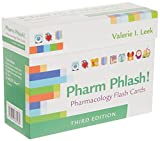
Focus on Pharmacology (8th Edition)
Focus on Nursing Pharmacology makes challenging concepts more approachable. Engaging learning features cultivate your clinical application, critical thinking and patient education capabilities. This updated 8th edition builds on your knowledge of physiology, chemistry and nursing fundamentals to help you conceptualize need-to-know information about each group of drugs.
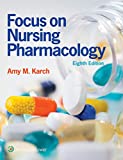
Pharmacology Made Incredibly Easy (Incredibly Easy! Series®)
Nursing pharmacology guide offers step-by-step guidance so you can grasp the fundamentals in enjoyable Incredibly Easy style. This is the perfect supplement to class materials, offering solid preparation for NCLEX® as well as a handy refresher for experienced nurses. Colorfully illustrated chapters offer clear, concise descriptions of crucial nursing pharmacology concepts and procedures.
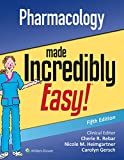
Lehne’s Pharmacology for Nursing Care (11th Edition)
The Eleventh Edition of Lehne’s Pharmacology for Nursing Care provides a thorough understanding of key drugs and their implications for nursing care. This text, written by renowned nursing educators, helps you comprehend and apply pharmacology principles. A clear and engaging writing style simplifies complex concepts, making even the most challenging pharmacology content enjoyable. We recommend this book if you want a comprehensive nursing pharmacology guide.
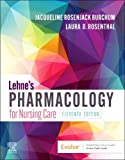
Nursing Drug Handbook
Nursing2023 Drug Handbook delivers evidence-based, nursing-focused drug monographs for nearly 3700 generic, brand-name, and combination drugs. With a tabbed, alphabetical organization and a “New Drugs” section, NDH2023 makes it easy to check drug facts on the spot.
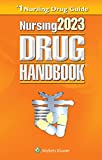
Pharmacology and the Nursing Process
The 10th edition of Pharmacology and the Nursing Process offers practical, user-friendly pharmacology information. The photo atlas contains over 100 unique illustrations and photographs depicting drug administration techniques. Updated drug content reflects the most recent FDA drug approvals, withdrawals, and therapeutic uses.
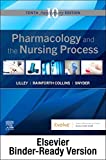
Mosby’s Pharmacology Memory NoteCards: Visual, Mnemonic, and Memory Aids for Nurses
The 6th edition of Mosby’s Pharmacology Memory NoteCards: Visual, Mnemonic, & Memory Aids for Nurses incorporates illustrations and humor to make studying easier and more enjoyable. This unique pharmacology review can be utilized as a spiral-bound notebook or as individual flashcards, making it ideal for mobile study.
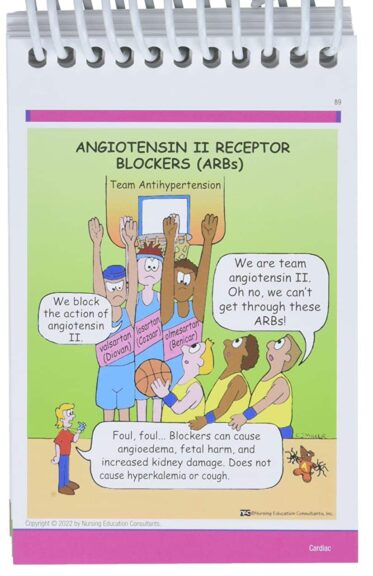
See Also
Here are other nursing pharmacology study guides:
- Nursing Pharmacology – Study Guide for Nurses
Our collection of topics related to nursing pharmacology - Pharmacology Nursing Mnemonics & Tips
These nursing mnemonics aim to simplify the concepts of pharmacology through the use of a simple, concise guide. - Generic Drug Name Stems Cheat Sheet
Learn about these generic drug name stems to help you make sense of drugs easier! - Common Drugs and Their Antidotes
A guide to drug antidotes that nurses should be familiar about. - IV Fluids and Solutions Guide & Cheat Sheet
Get to know the different types of intravenous solutions or IV fluids in this guide and cheat sheet. - Drug Dosage Calculations NCLEX Practice Questions (100+ Items)
Care to take the challenge? This quiz aims to help students and registered nurses alike grasp and master the concepts of medication calculation.
Drug Guides NEW!
Individual drug guides and nursing considerations for the most common medications used in nursing pharmacology:
- Acetaminophen (Tylenol)
- Aspirin
- Atorvastatin (Lipitor)
- Enoxaparin (Lovenox)
- Furosemide (Lasix)
- Gabapentin
- Hydromorphone (Dilaudid)
- Lisinopril
- Metoprolol
- Morphine
Gastrointestinal System Drugs
Respiratory System Drugs
- Antihistamines
- Bronchodilators and Antiasthmatics
- Decongestants
- Expectorants and Mucolytics
- Inhaled Steroids
- Lung Surfactants
Endocrine System Drugs
- Adrenocortical Agents
- Antidiabetic Agents
- Glucose-Elevating Agents
- Hypothalamic Agents
- Insulin
- Parathyroid Agents: Bisphosphonates, Calcitonins
- Pituitary Drugs
- Sulfonylureas
- Thyroid Agents
Autonomic Nervous System Drugs
- Adrenergic Agonists (Sympathomimetics)
- Adrenergic Antagonists (Sympatholytics)
- Anticholinergics (Parasympatholytics)
- Cholinergic Agonists (Parasympathomimetics)
Immune System Drugs
Chemotherapeutic Agents
- Anthelmintics
- Anti-Infective Drugs
- Antibiotics
- Antifungals
- Antineoplastic Agents
- Antiprotozoal Drugs
- Antiviral Drugs
Reproductive System Drugs
Nervous System Drugs
- Antidepressants
- Antiparkinsonism Drugs
- Antiseizure Drugs
- Anxiolytics and Hypnotic Drugs
- General and Local Anesthetics
- Muscle Relaxants
- Narcotics, Narcotic Agonists, and Antimigraine Agents
- Neuromuscular Junction Blocking Agents
- Psychotherapeutic Drugs
Cardiovascular System Drugs
References and Sources
References and sources for this pharmacology guide for Male Reproductive Drugs:
- Karch, A. M., & Karch. (2011). Focus on nursing pharmacology. Wolters Kluwer Health/Lippincott Williams & Wilkins. [Link]
- Katzung, B. G. (2017). Basic and clinical pharmacology. McGraw-Hill Education.
- Lehne, R. A., Moore, L. A., Crosby, L. J., & Hamilton, D. B. (2004). Pharmacology for nursing care.
- Smeltzer, S. C., & Bare, B. G. (1992). Brunner & Suddarth’s textbook of medical-surgical nursing. Philadelphia: JB Lippincott.
